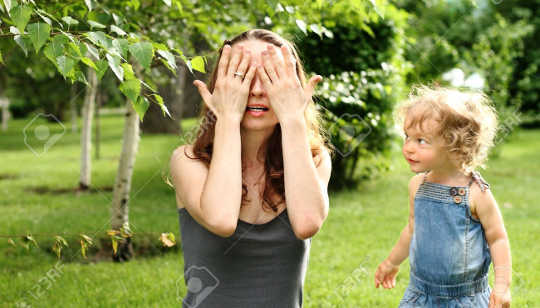
Young children across the globe enjoy playing games of hide and seek. There’s something highly exciting for children about escaping someone else’s glance and making oneself “invisible.”
However, developmental psychologists and parents alike continue to witness that before school age, children are remarkably bad at hiding. Curiously, they often cover only their face or eyes with their hands, leaving the rest of their bodies visibly exposed.
For a long time, this ineffective hiding strategy was interpreted as evidence that young children are hopelessly “egocentric” creatures. Psychologists theorized that preschool children cannot distinguish their own perspective from someone else’s. Conventional wisdom held that, unable to transcend their own viewpoint, children falsely assume that others see the world the same way they themselves do. So psychologists assumed children “hide” by covering their eyes because they conflate their own lack of vision with that of those around them.
But research in cognitive developmental psychology is starting to cast doubt on this notion of childhood egocentrism. We brought young children between the ages of two and four into our Minds in Development Lab at USC so we could investigate this assumption. Our surprising results contradict the idea that children’s poor hiding skills reflect their allegedly egocentric nature.
Who can see whom?
Each child in our study sat down with an adult who covered her own eyes or ears with her hands. We then asked the child whether or not she could see or hear the adult, respectively. Surprisingly, children denied that they could. The same thing happened when the adult covered her own mouth: Now children denied that they could speak to her.
A number of control experiments ruled out that the children were confused or misunderstood what they were being asked. The results were clear: Our young subjects comprehended the questions and knew exactly what was asked of them. Their negative responses reflected their genuine belief that the other person could not be seen, heard, or spoken to when her eyes, ears, or mouth were obstructed. Despite the fact that the person in front of them was in plain view, they flatout denied being able to perceive her. So what was going on?
It seems like young children consider mutual eye contact a requirement for one person to be able to see another. Their thinking appears to run along the lines of “I can see you only if you can see me, too” and vice versa. Our findings suggest that when a child “hides” by putting a blanket over her head, this strategy is not a result of egocentrism. In fact, children deem this strategy effective when others use it.
Built into their notion of visibility, then, is the idea of bidirectionality: Unless two people make eye contact, it is impossible for one to see the other. Contrary to egocentrism, young children simply insist on mutual recognition and regard.
An expectation of mutual engagement
Children’s demand of reciprocity demonstrates that they are not at all egocentric. Not only can preschoolers imagine the world as seen from another’s point of view; they even apply this capacity in situations where it’s unnecessary or leads to wrong judgments, such as when they are asked to report their own perception. These faulty judgments – saying that others whose eyes are covered cannot be seen – reveal just how much children’s perception of the world is colored by others.
The seemingly irrational way in which children try to hide from others and the negative answers they gave in our experiment show that children feel unable to relate to a person unless the communication flows both ways – not only from me to you but also from you to me, so we can communicate with each other as equals.
We are planning to investigate children’s hiding behavior directly in the lab and test if kids who are bad at hiding show more reciprocity in play and conversation than those who hide more skillfully. We would also like to conduct these experiments with children who show an atypical trajectory in their early development.
Our findings underscore children’s natural desire and preference for reciprocity and mutual engagement between individuals. Children expect and strive to create situations in which they can be reciprocally involved with others. They want to encounter people who are not only looked at but who can return another’s gaze; people who not only listen but are also heard; and people who are not just spoken to but who can reply and thus enter a mutual dialogue.
At least in this respect, young children understand and treat other human beings in a manner that is not at all egocentric. On the contrary, their insistence on mutual regard is remarkably mature and can be considered inspirational. Adults may want to turn to these preschoolers as role models when it comes to perceiving and relating to other humans. These young children seem exquisitely aware that we all share a common nature as people who are in constant interaction with others.
![]()
About The Author
Henrike Moll, Assistant Professor in Developmental Psychology, University of Southern California – Dornsife College of Letters, Arts and Sciences and Allie Khalulyan, Ph.D. Student in Developmental Psychology, University of Southern California – Dornsife College of Letters, Arts and Sciences
This article was originally published on The Conversation. Read the original article.
Related Books
at InnerSelf Market and Amazon


























